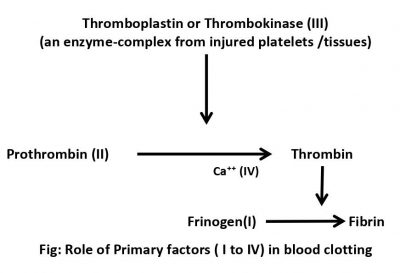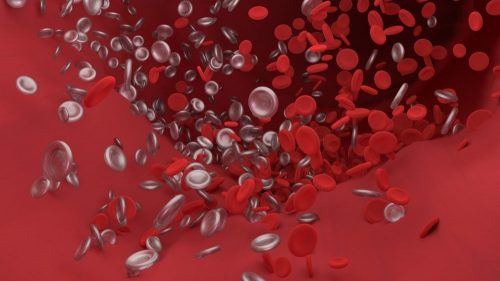The clot or coagulam is a dark -reddish-brown ‘scum’ formed mainly by a network of threads in which dead or damaged blood elements are trapped.
- It is the property of plasma.
- Normal blood clotting time is 3−10 min.
- The clot inside the blood vessels is called a thrombus. A moving thrombus is called embolus.
- In haemophilia (a sex-linked disease) the blood clotting is delayed.
- According to Macferlane hypothesis, there are 13−factors responsible for blood clotting (or coagulation). The 4−factors are primary and 9−factors are accessory for this process.
- Fibrinogen
- Prothrombin
- Thromboplastin (Thrombokinase)
- Calcium ions

Accessory factors
(V) Labile factor (Proaccelerin) − It helps incomplete conversion of prothrombin into thrombin.
(VI) No separate entity, hence No specific name (existence doubtful).
(VII) Stable factor (Proconvertin) − It accelerates the formation of active
thromboplastin.
(VIII) Anti−haemophilic globulin (AHG)− The absence of this factor delays blood clotting causing Haemophilia−A. This type of haemophilia is most common (80%).
(IX) Plasma thromboplastin co−factor (PTC)− The deficiency of this factor causes Haemophilia−B. Approximately 20% of haemophilic patients have this type of haemophilia. The IX factor is also known as Christmas factor and Haemophilia
B is known as ‘Christmas disease’.
(X) Stuart Prower factor− It helps in the conversion of prothrombin into thrombin.
(XI) Plasma thromboplastin antecedent (PTA)− It activates the inactive christmas factor. The deficiency of this causes a rare type of bleeder-disease, called
Haemophilia -C.
(XII) Hageman’s factor or Glass factor − It converts inactive PTA into active form. It also dilates blood vessels for increasing their permeability.
(XIII) Fibrin stabilizing factor− It causes polymerization of soluble fibrin into insoluble fibrin and also inhibits depolymerization.
Factors slowing blood clotting−
- Inside body− Heparin is a natural anticoagulant present in the blood. It prevents conversion of prothrombin into thrombin and does not allow blood coagulation inside blood vessels.
- Outside body− sodium citrate, sodium oxalate, double oxalate and EDTA (ethylene diamine tetraacetic acid) and the other chelating agents bind with free calcium and prevent the conversion of prothrombin into thrombin. Dicumarol and Warfarin inhibit the action of vitamin K (anti- prothrombin function) and thus prevent blood clotting.
Factors hastening blood clotting−
- Inside body− Vitamin K, which is essential for the synthesis of prothrombin in the liver, if injected into the body, during haemorrhage, stimulates blood clotting.
- Outside body− The blood oozing out from injured part can be coagulated by applying pressure or providing rough surface (for injuring more platelets) or by increasing the temperature (to activate blood clotting− enzymes)





Leave a Reply
You must be logged in to post a comment.